Italeri 1/72nd Dornier Do-217 - E3/E4/E5
|
 |
Background
Although the Do-217E-1 proved relatively effective during
early operations, experience dictated increases in both offensive and
defensive armament, the provision of some armor protection for the crew,
and other changes aimed at increasing the versatility of the basic aircraft.
These modifications led to a change in designation to Do 217E-3. A free
mounted 20mm MG FF cannon was installed in the lower starboard side of
the nose for use in anti-shipping strikes, and two additional gimbal-mounted
7.9mm machine guns were added to fire laterally from cockpit windows immediately
aft of the pilot. The E-3 had no fewer than seven 7.9mm machine guns but
five of the guns were to be fired by the radio-operator alone, thus only
a light weight of fire could be placed upon the enemy. With increased
armor to protect the crew and a large number of Rüstsätze
to increase the versatility of the basic aircraft, the E-3 was delivered
to the three Gruppen of Kampfgeschwader 2 based along
the channel coast for sorties against Great Britain.
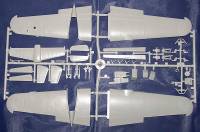 Late
in 1941, the assembly lines began to switch from the Do-217E-2 to the
E-4 which came into operational use early in 1942. The E-4 differed in
minor aspects from the E-2 and E-3 in that the BMW-801C engines were delivered
as bare power plants instead of the “power egg” (engine and
cowling delivered as a package) versions of the BMW-801MA or ML of the
E-2 or E-3, and in being fitted with the so-called Kuto-Nase
balloon-cable cutter in the wing leading edge. A small number of late-production
examples were modified on the assembly line as parent aircraft for the
Henschel HS293A stand-off missile launcher under the designation Do 217E-5.
They were fitted with an ETC 2000/XII carrier under each outboard wing
panel, transmitters and a joystick for line of sight guidance for the
Henschel missile. Kampfgruppe 100 launched the first Hs 293A
missiles against Allied destroyers in the Bay of Biscay on August 25,
1943. Late
in 1941, the assembly lines began to switch from the Do-217E-2 to the
E-4 which came into operational use early in 1942. The E-4 differed in
minor aspects from the E-2 and E-3 in that the BMW-801C engines were delivered
as bare power plants instead of the “power egg” (engine and
cowling delivered as a package) versions of the BMW-801MA or ML of the
E-2 or E-3, and in being fitted with the so-called Kuto-Nase
balloon-cable cutter in the wing leading edge. A small number of late-production
examples were modified on the assembly line as parent aircraft for the
Henschel HS293A stand-off missile launcher under the designation Do 217E-5.
They were fitted with an ETC 2000/XII carrier under each outboard wing
panel, transmitters and a joystick for line of sight guidance for the
Henschel missile. Kampfgruppe 100 launched the first Hs 293A
missiles against Allied destroyers in the Bay of Biscay on August 25,
1943.
The Kit
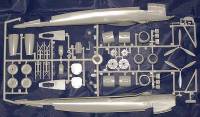 The
Italeri D0-217 E3/E4/E5 comes in those wonderful top-loading boxes that
I love so much. The kit is molded in the same standard gray styrene as
the other Do-217s that Italeri has produced in the past and as it turns
out, this is just a modification of the Do-217K kit that was introduced
in the early 80’s. You can actually see where they cut off the K
nose and grafted the new one in its place. The model still has raised
panel lines to match the rest of the series, in fact the panel lines on
the new nose are finer and not as high as the original parts of the kit. The
Italeri D0-217 E3/E4/E5 comes in those wonderful top-loading boxes that
I love so much. The kit is molded in the same standard gray styrene as
the other Do-217s that Italeri has produced in the past and as it turns
out, this is just a modification of the Do-217K kit that was introduced
in the early 80’s. You can actually see where they cut off the K
nose and grafted the new one in its place. The model still has raised
panel lines to match the rest of the series, in fact the panel lines on
the new nose are finer and not as high as the original parts of the kit.
With a new nose Italeri could have added some interior detail to busy
up the front office, especially since the clear nose glazing exposes even
more of the empty interior. Hopefully Eduard or Aires will provide an
update kit to make this latest of German bomber kits even better.
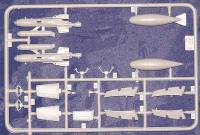 I
test fitted the fuselage together and found that you will hack off some
of the attachment pins to get a clean fit. I also checked the fit of the
new nose glazing, this was less than satisfactory. The glazing is too
large and will require some sanding and polishing along the sides to get
it to sit flush with the rest of the fuselage. There are gaps at the top
of the glazing will be frustrating to close. The frames on the nose are
much too large compared to the finely molded frames on the original canopy.
Someone got a bit sloppy when they engineered this. Here is an opportunity
for Squadron or Falcon to provide a new nose glazing, not to just replace
the nose, but to provide the opportunity to make the E3 version of this
kit. As I mentioned in the background section of this article, the E3
had a number of gimbaled machine guns in the rear part of the canopy.
Italeri does not provide any way to mount the guns (although some are
provided but not used in the versions mentioned in the directions) in
the present canopy. And, since we are talking about the E3, the 20mm gun
is not provided as well as a way to mount the guns. In fact, the only
version supported by this model kit is a late E4 or E5. Cottage industries
please take note, here is a model that could really benefit from your
services! I
test fitted the fuselage together and found that you will hack off some
of the attachment pins to get a clean fit. I also checked the fit of the
new nose glazing, this was less than satisfactory. The glazing is too
large and will require some sanding and polishing along the sides to get
it to sit flush with the rest of the fuselage. There are gaps at the top
of the glazing will be frustrating to close. The frames on the nose are
much too large compared to the finely molded frames on the original canopy.
Someone got a bit sloppy when they engineered this. Here is an opportunity
for Squadron or Falcon to provide a new nose glazing, not to just replace
the nose, but to provide the opportunity to make the E3 version of this
kit. As I mentioned in the background section of this article, the E3
had a number of gimbaled machine guns in the rear part of the canopy.
Italeri does not provide any way to mount the guns (although some are
provided but not used in the versions mentioned in the directions) in
the present canopy. And, since we are talking about the E3, the 20mm gun
is not provided as well as a way to mount the guns. In fact, the only
version supported by this model kit is a late E4 or E5. Cottage industries
please take note, here is a model that could really benefit from your
services!
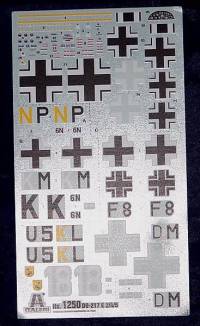 Talking
about cottage industries, AIMS
has a replacement cowl and engine front for the Italeri line of Do-217s
that use the BMW engines. For those that want to replace the dubious cowling
and have a better looking pair of engines, this company has the only set
in town. Talking
about cottage industries, AIMS
has a replacement cowl and engine front for the Italeri line of Do-217s
that use the BMW engines. For those that want to replace the dubious cowling
and have a better looking pair of engines, this company has the only set
in town.
I didn’t mean to take this kit apart and damn it so heavily, but
as I started looking closer at the kit the blemishes really started to
come out. That said, the kit really shines if you want to build an E5.
The Henschel Hs 293A missile with its accompanying drop tank is a little
gem of a kit. It has engraved panel lines and is matched by some rather
detailed ETC racks to carry them. The ETC racks have raised panel lines
but they do not detract at all from the beautiful detail of this extra
sprue.
The decal sheet has subjects for four different aircraft. Everything
was in perfect register but no swastikas were provided. Once again we
have to bow down to German law and find them from a different vendor.
One of the aircraft is an E3 from KG 2 and that is why I had to bash this
particular kit so hard because Italeri did not provide a way to properly
build an E3 straight from the box.
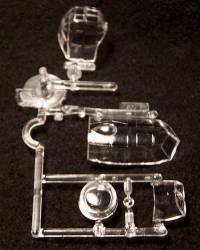 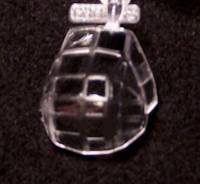 Conclusion Conclusion
Now, after all the haranguing I did about this kit, don’t think
I didn’t like it. This is a long awaited version of the Do 217 and
can build up into a nice kit. I will have to add an update kit, perhaps
modifying the Eduard PE K set will work just to make the cockpit more
interesting. This is a highly recommended kit, especially for those that
have the previous kits and want to continue to fill out the Dornier line.
My thanks to Testors and Internet
Modeler for the review sample. |
|
